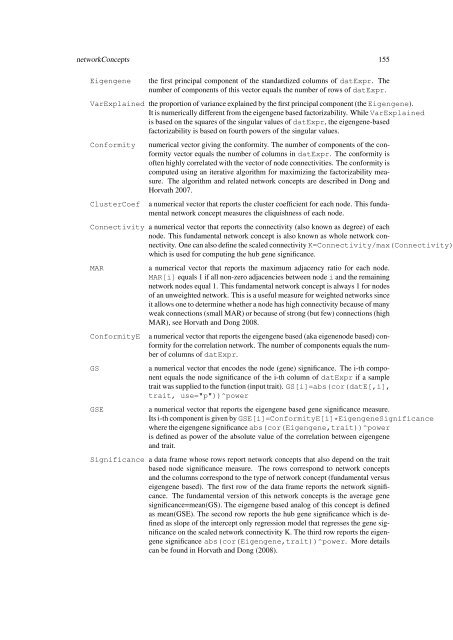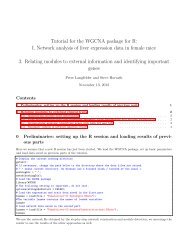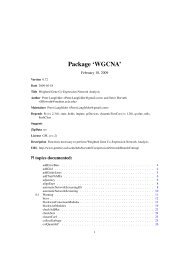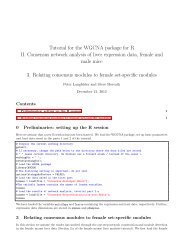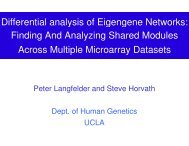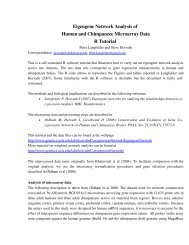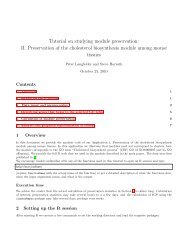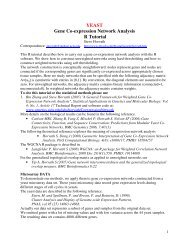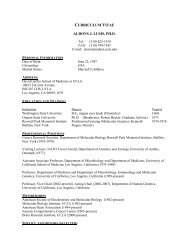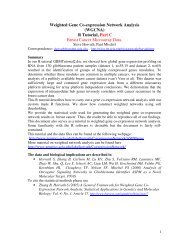Package 'WGCNA' - UCLA Human Genetics
Package 'WGCNA' - UCLA Human Genetics
Package 'WGCNA' - UCLA Human Genetics
You also want an ePaper? Increase the reach of your titles
YUMPU automatically turns print PDFs into web optimized ePapers that Google loves.
networkConcepts 155Eigengenethe first principal component of the standardized columns of datExpr. Thenumber of components of this vector equals the number of rows of datExpr.VarExplained the proportion of variance explained by the first principal component (the Eigengene).It is numerically different from the eigengene based factorizability. While VarExplainedis based on the squares of the singular values of datExpr, the eigengene-basedfactorizability is based on fourth powers of the singular values.ConformityClusterCoefnumerical vector giving the conformity. The number of components of the conformityvector equals the number of columns in datExpr. The conformity isoften highly correlated with the vector of node connectivities. The conformity iscomputed using an iterative algorithm for maximizing the factorizability measure.The algorithm and related network concepts are described in Dong andHorvath 2007.a numerical vector that reports the cluster coefficient for each node. This fundamentalnetwork concept measures the cliquishness of each node.Connectivity a numerical vector that reports the connectivity (also known as degree) of eachnode. This fundamental network concept is also known as whole network connectivity.One can also define the scaled connectivity K=Connectivity/max(Connectivity)which is used for computing the hub gene significance.MARConformityEGSGSEa numerical vector that reports the maximum adjacency ratio for each node.MAR[i] equals 1 if all non-zero adjacencies between node i and the remainingnetwork nodes equal 1. This fundamental network concept is always 1 for nodesof an unweighted network. This is a useful measure for weighted networks sinceit allows one to determine whether a node has high connectivity because of manyweak connections (small MAR) or because of strong (but few) connections (highMAR), see Horvath and Dong 2008.a numerical vector that reports the eigengene based (aka eigenenode based) conformityfor the correlation network. The number of components equals the numberof columns of datExpr.a numerical vector that encodes the node (gene) significance. The i-th componentequals the node significance of the i-th column of datExpr if a sampletrait was supplied to the function (input trait). GS[i]=abs(cor(datE[,i],trait, use="p"))^powera numerical vector that reports the eigengene based gene significance measure.Its i-th component is given by GSE[i]=ConformityE[i]*EigengeneSignificancewhere the eigengene significance abs(cor(Eigengene,trait))^poweris defined as power of the absolute value of the correlation between eigengeneand trait.Significance a data frame whose rows report network concepts that also depend on the traitbased node significance measure. The rows correspond to network conceptsand the columns correspond to the type of network concept (fundamental versuseigengene based). The first row of the data frame reports the network significance.The fundamental version of this network concepts is the average genesignificance=mean(GS). The eigengene based analog of this concept is definedas mean(GSE). The second row reports the hub gene significance which is definedas slope of the intercept only regression model that regresses the gene significanceon the scaled network connectivity K. The third row reports the eigengenesignificance abs(cor(Eigengene,trait))^power. More detailscan be found in Horvath and Dong (2008).


